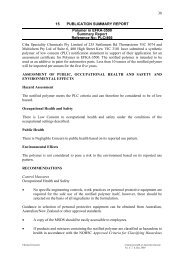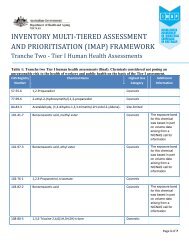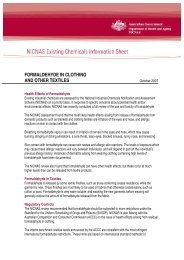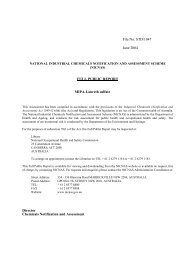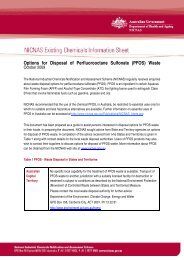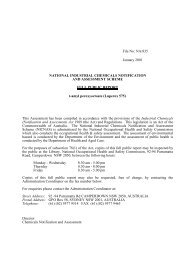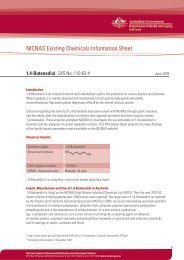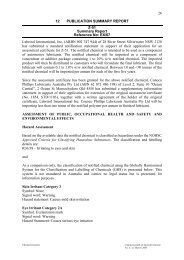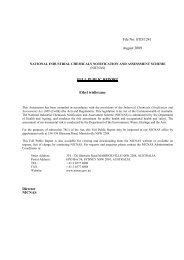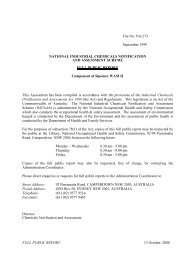GULFTENE C16-18 ISOMERISED OLEFINS - NICNAS
GULFTENE C16-18 ISOMERISED OLEFINS - NICNAS
GULFTENE C16-18 ISOMERISED OLEFINS - NICNAS
You also want an ePaper? Increase the reach of your titles
YUMPU automatically turns print PDFs into web optimized ePapers that Google loves.
esultant oil/water emulsion is passed to an on site waste treatment facility where the oils and<br />
water are separated and eventually become incorporated into a waste sludge. The waste<br />
sludge is typically incinerated.<br />
The use pattern of Gulftene 16-<strong>18</strong> is such that all material used in drilling muds is expected to<br />
be released with the waste drill cuttings to the marine environment. The drill cuttings may<br />
contain up to 10% of Gulftene 16-<strong>18</strong> and are discharged through a pipe just below the surface<br />
to eventually settle to the sea floor. However, depending on factors such as particle size sea<br />
conditions, weather conditions and ocean currents, the deposition may take some time. Also,<br />
it is likely that the distribution would be disperse and that the discarded cuttings would be<br />
spread over a fairly wide area of the sea floor. A typical production drilling platform may<br />
have more than ten individual bore holes, each between one and four km in length.<br />
Given that the typical diameter of a production hole is 31.1 cm, each platform is estimated to<br />
produce between 3 000 and 12 000 m 3 of rock cuttings with a weight of approximately 8 000<br />
to 30 000 tonnes (Cobby 1999). Assuming that the cuttings contain 10% of drilling fluid,<br />
each pile of cuttings may contain up to 3 000 tonnes of discarded fluid. Note here that<br />
Gulftene 16-<strong>18</strong> is one of a class of materials used in the preparation of the drilling muds.<br />
These may include internal olefins, poly alpha olefins, linear alpha olefins, esters and acetals<br />
(Cobby 1999).<br />
Also, some of the residual fluid may remain “entrained” between particles of rock cuttings<br />
and not adsorbed to the surface of these solids. After discharge overboard this material would<br />
be expected to migrate to the sea surface and could form a film on the surface of the water.<br />
The notifier acknowledged that while the formation of such a “slick” is possible it would be<br />
unlikely except during extremely still weather and sea conditions. Any surface film formed<br />
from the notified chemical in this manner could be expected to slowly spread from the<br />
vicinity of the drilling rig to be eventually broken up by wind and waves. Since the<br />
compound is volatile (Henry’s Law Constant around 200 Pa m 3 /mole), it is expected that<br />
most of the material would evaporate from the surface and enter the atmosphere.<br />
8.2 FATE<br />
8.2.1 BIODEGRADATION<br />
Gulftene 16-<strong>18</strong> will be released in large quantities to the sea floor. Since conditions within<br />
the marine benthic zone may be either aerobic or anaerobic, it is necessary to consider the fate<br />
of the material in both these environments.<br />
8.2.1.a Aerobic Conditions - Freshwater Studies<br />
The following tests were conducted on cogener substances, C20-24 alkenes, branched and<br />
linear, <strong>C16</strong> alkenes and Gulftene C14.<br />
Ready Biodegradability - CO2 Evolution Test (Safepharm Laboratories Limited 1998)<br />
Test Substance: C20-24 alkenes, branched and linear<br />
FULL PUBLIC REPORT 26 April 2000<br />
NA/713 Page 11 of 100



